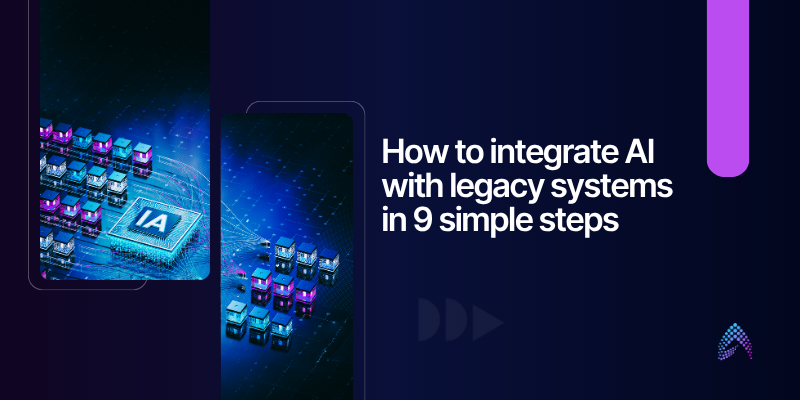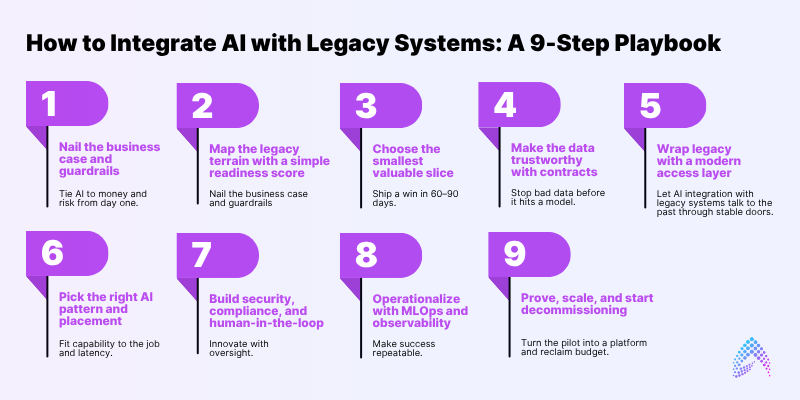How to integrate AI with legacy systems in 9 simple steps

Introduction:
Don’t be like a boiling frog in the current digital and AI-led era. If you act like the boiling frog, calmly acclimating to rising tech temperature, you won’t notice you’ve slipped from “reliable” to “irrelevant.”
Your current systems and architectures might be good enough to get the job done, but not to compete with modern business models.
Modern businesses and startups are slashing down their CapEx costs by adopting AI, low-code, and other hyper-automation methods. On the other hand, more than 80% of enterprises still rely on decade-old applications, struggling to make progress and scale.
In 2025, AI integration and adoption is everywhere. But legacy technology isn’t going anywhere either. According to a Forbes report, 90% of businesses still run core functionalities on outdated applications.
Why legacy systems and architectures fail:
Legacy systems feel safe until you see the bill. Gartner estimates that 70% to 80% of IT budgets go to keeping them alive, leaving only 20% to 30% for innovation. Meanwhile, unplanned outages occur five times more often and cost mid-sized businesses about $84,000 per hour. Supporting obsolete hardware adds insult to injury, running at roughly three times the cost of modern options. That is not stability.
These serious issues raised the bar for legacy modernization with AI to save cost and time. Also, AI-driven legacy transformation enable organization to have transparency across the organization and thus allow make smarter decisions.

1. Technical debt
Technology evolves every day; so every business must adopt it to stay relevant. On the other hand, technical debt is the “interest” you pay for years of shortcuts, one-off patches, and deferred upgrades. Codebases accumulate brittle workarounds, hard-coded business rules, and dependencies tied to end-of-life runtimes.
The result is a system that’s difficult to change without breaking something else, with release cycles that slow from weeks to quarters. Security exposure rises because old libraries and platforms aren’t patched quickly. Teams spend more time stabilizing the past than building the future, and every new feature request becomes a negotiation with risk.
A 2024 report estimates the economic drag of technical debt in the United States at 1.52 trillion dollars, with some estimates even higher.
2. Lack of documentation
Documentation is paramount in product and software development. When documentation is missing or outdated, knowledge lives in a few people’s heads. Onboarding stretches from weeks to months, incident resolution depends on finding the “one person who knows,” and knowledge transfer between teams fails under pressure.
Integration projects stall because no one can explain data semantics, side effects, or error codes. Audits are painful, and continuity evaporates when key staff leave. Even simple changes require detective work, increasing cost, delay, and the chance of unintended consequences. With legacy systems in place, their documentation has become an extinct thing for many businesses, leaving them in operational chaos.
3. High maintenance
4. Poor data and incompatibility
In the modern business era, data fuels operations and scalability. For years, enterprises have relied on legacy data architectures to keep their operations running.
Data quality and compatibility issues are silent killers. Inconsistent schemas, duplicate records, and ambiguous business definitions undermine analytics and AI. Older systems may store data in proprietary formats, legacy encodings, or COBOL copybooks that don’t align with modern tools.
Integrations fail on details like time zones, character sets, unexpected nulls, or schema drift between environments. Without data contracts, lineage, and stewardship, teams cannot trust the numbers, automations misfire, and cross-system projects bog down in cleansing and reconciliation instead of delivering outcomes.
5. Legacy systems are not API-ready
Much legacy functionality is trapped behind green-screen flows, thick client UIs, or stored procedures with opaque side effects. There are no stable, documented APIs, no standard authentication or authorization, and no pagination or rate limits. That forces teams into brittle screen-scraping or expensive, bespoke adapters for each integration.
Observability, governance, and security suffer because there’s no consistent contract to monitor or control. Without API-level access, you cannot compose services, expose capabilities to partners, or plug AI agents and modern apps into core processes.
AI integration and adoption impact on businesses: Stats
Let’s have a look at the real-time results of integrating AI with legacy systems.
In 2025, an AI agent can converse with a customer and plan the actions it will take afterward. For example, processing a payment, checking for fraud, and completing a shipping action.
92 percent of business leaders say they expect to boost spending on AI in the next three years, with 55 percent expecting investments to increase by at least 10 percent from current levels.
How to Integrate AI with Legacy Systems: A 9-Step Playbook

AI integration with legacy systems isn’t just about connecting two systems and waiting for magic to happen. You need a disciplined approach that identifies what already works while layering intelligence on top of it to reap the best benefits of AI. Here is a simple and effective playbook to integrate AI with legacy systems.
1. Nail the business case and guardrails
Goal: Tie AI to money and risk from day one.
Do this: Write a one-page brief per use case: business outcome → operational KPI (e.g., claim cycle time) → model KPI (precision/latency) → risk guardrails
2. Map the legacy terrain with a simple readiness score
Goal: Know where AI can attach safely.
Do this: Inventory systems and score each on the 6Cs plus two: Cost, Compliance, Complexity, Connectivity, Competitiveness, Customer impact, Changeability, Criticality.
3. Choose the smallest valuable slice
Goal: Ship a win in 60–90 days.
Do this: Select one process slice (e.g., invoice triage, routing recommendations, or handling customer enquiries). Limit scope to one region or product line. Set target KPIs and a clear exit/scale criterion.
4. Make the data trustworthy with contracts
Goal: Stop bad data before it hits a model.
Do this: Define data contracts for each feed: schema, ranges, null policy, freshness, lineage, PII rules, and owner. Enforce contracts in pipelines; fail builds on drift.
5. Wrap legacy with a modern access layer
Goal: Let AI integration with legacy systems talk to the past through stable doors.
Do this: Stand up an API façade or micro-gateway over mainframe/ERP functions. Add auth, rate limits, pagination, and consistent error codes
6. Pick the right AI pattern and placement
Goal: Fit capability to the job and latency.
Do this:
Decision support & knowledge: add a RAG layer (index policies, SOPs, tickets) so the model cites sources.
Prediction/classification: supervised ML with a feature store.
Where to run: co-locate near data/latency needs (edge vs cloud)
7. Build security, compliance, and human-in-the-loop
Goal: Innovate with oversight.
Do this: Zero-trust service identities, encryption, policy-as-code for data access, retention, and PII masking. Add human review for high-impact steps; capture rationale and citations for audits.
8. Operationalize with MLOps and observability
Goal: Make success repeatable.
Do this: Model registry tied to data versions; CI/CD with quality gates (static analysis, SBOM, contract tests); canary/blue-green deploys; drift monitors for data and predictions; auto-rollback on breach.
9. Prove, scale, and start decommissioning
Goal: Turn the pilot into a platform and reclaim budget.
Do this: Compare KPIs to baseline; publish ROI. Expand to the next slice. Use the strangler-fig pattern to retire legacy modules as APIs/events take over. Track FinOps metrics (cost per prediction, per transaction).
AI Integration With Legacy Systems: A Winning Fabric
AI integration with legacy systems doesn’t need to topple your legacy stack to create value; it needs to interact with it reliably. The win is a connected process fabric where legacy systems, modern apps, and AI agents work as one end-to-end flow with full visibility.
Make the connection your advantage:
Wrap legacy capabilities behind stable APIs and/or event streams so AI can read, act, and record outcomes consistently.
Use orchestration to sequence tasks, enforce guardrails, and capture telemetry across every handoff.
Standardize on observability and identity so actions are attributable and reversible.
Measure flow with business-level SLAs (cycle time, first-pass yield, exception rate), not just system uptime.
Do this well and you reduce AI integration risk, accelerate modernization, and build a process architecture that’s ready for whatever comes next, new regulations, new channels, new AI models, without a disruptive rewrite.
Frequently Asked Questions
What’s the safest way to start integrating AI with legacy systems?
Begin with one high-value slice (e.g., triage or routing), expose needed functions via an API façade, and use read-only data first. Set success KPIs and expand only after a stable win.
Do we need to replace legacy apps to benefit from AI?
No. Wrap them. Add a micro-gateway or event façade so AI can read, infer, and write back through governed interfaces—modern value without a big-bang rewrite.
How do we keep data quality from sinking results?
Define data contracts per feed (schema, freshness, null rules, PII), enforce automated checks in pipelines, and fail builds on contract violations before models see bad inputs.
What security and compliance controls are essential?
Zero-trust service identities, encryption in transit/at rest, policy-as-code for data access/retention, decision logging with model/version, and human approval for high-impact steps.

Director ATG & AI Practice




